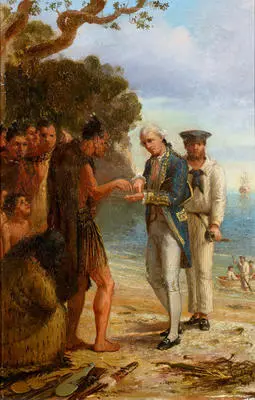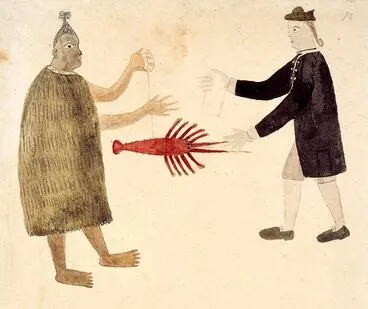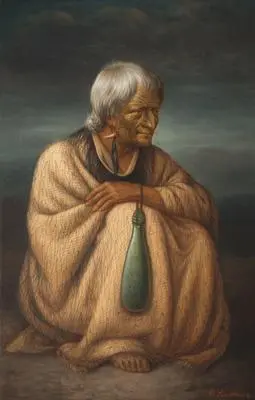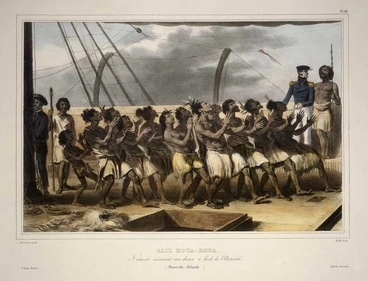First Encounters Artwork
A DigitalNZ Story by Erena Williamson
A set of paintings, drawings, engravings and stamps relating to first encounters between Māori and Europeans in Aotearoa New Zealand.
First encounters New Zealand, New Zealand history, Captain Cook, Abel Tasman, Marion du Fresne, Joseph-Antoine Raymond Bruny d'Entrecasteaux, Jules Sebastien Cesar Demont d'Urville
Abel Tasman - 1642
Abel Tasman is officially recognised as the first European to ‘discover’ Aotearoa New Zealand in 1642. His men were the first Europeans to have a confirmed encounter with Māori.
Source: Abel Tasman , NZ History
Small image of Tasman on card mounted on black paper (artist and date unknown).
Abel Tasman
Auckland War Memorial Museum Tāmaki Paenga Hira
Engraving by Isaac Gilsemans (date unknown), who was onboard ship with Tasman when he visited Aotearoa in 1642-1643.
Gilsemans, Isaac, fl 1630s-1645? :Afbeelding van de inwooneren van Nieuw Zeeland. [Amsterdam, 1784]
Alexander Turnbull Library
Isaac Gilsemans drew the Three Kings Islands. Tasman’s ship anchored off the islands on 5 January 1643.
Three Kings Islands
Manatū Taonga, the Ministry for Culture and Heritage
Description: 'Created by Jacob van Schley and Isaac Gilsemans on or around the date 01 January, 1758'.
Murderers Bay (Baye des Meurtriers/ De Moodenaars Baay)
Museum of New Zealand Te Papa Tongarewa
Gilseman sketched the coast from just north of Punakaiki up to Rocky Point, today’s Cape Foulwind (date unknown).
Tasman’s first view of New Zealand
Manatū Taonga, the Ministry for Culture and Heritage
Jean Francois marie de Surville - 1769
De Surville arrived off Hokianga on 12 December, went north in search of a suitable anchorage and rounded North Cape on 17 December, in a storm which had blown James Cook, then sailing north up the east coast, just out of sight of land.
Source: Surville, Jean François Marie de, Te Ara - the Encyclopedia of New Zealand
1997 stamp honouring de Surville, featuring his ship, St Jean Baptiste, and the pā site at Tokerau where they landed.
Commemorating New Zealand’s discovery
Manatū Taonga, the Ministry for Culture and Heritage
Captain James Cook - 1769, 1772, 1776
As captain on three voyages of discovery in the late eighteenth century, James Cook became the first European to define the outline of New Zealand.
Source: James Cook, NZ History
Pen and ink sketch (artist and date unknown).
Captain James Cook
Auckland War Memorial Museum Tāmaki Paenga Hira
Artwork by John Louise Steele and Charles Henry Kennett Watkins (1769).
Arrival of Captain Cook; An incident in the Bay of Islands, 29 November 1769
Auckland Art Gallery Toi o Tāmaki
Tahitian Tupaia created this work while he was on board the Endeavour with Captain Cook.
Tupaia's painting of Joseph Banks
Manatū Taonga, the Ministry for Culture and Heritage
This engraving is based on a sketch by H. D. Spöring, the naturalist on Cook's first voyage to Aoteaoroa (date unknown).
Arched rock, Tolaga Bay
Manatū Taonga, the Ministry for Culture and Heritage
Engraving by Herman Diedrich Sporing (1769-1784) of a view from Cook's Cove looking through to Tolaga Bay.
A larger view (by another Artist) of that celebrated Natural Curiosity, the Perforated Rock in Tolaga Bay in New Zealand
Auckland Art Gallery Toi o Tāmaki
Engraving by Herman Diedrich Sporing (1769-1773) of Mercury Bay, rather than Tolaga Bay as claimed in the title.
A Fortified village called a Hippah, built on a perforated rock at Tolaga in New Zealand
Auckland Art Gallery Toi o Tāmaki
A copy of a sketch of a Māori warrior by Sydney Parkinson, an artist who was on board the Endeavour in 1769.
Māori warrior
Manatū Taonga, the Ministry for Culture and Heritage
This hand-coloured engraving was made by Sydney Parkinson, the artist on board Captain Cook’s Endeavour in 1769.
Arched rock, Mercury Bay
Manatū Taonga, the Ministry for Culture and Heritage
Engraving by William Hodges (mid-1770s) of Māori at Dusky Sound, Fiordland, during Cook's second visit to Aotearoa.
Māori at Dusky Sound
Manatū Taonga, the Ministry for Culture and Heritage
Painting by John Webber (date unknown), official artist on Cook's ship the Resolution during Cook's third visit.
Māori at Ship Cove
Manatū Taonga, the Ministry for Culture and Heritage
Sydney Parkinson recorded hairstyles and adornment during Cook's voyage to Aotearoa New Zealand in 1769-1770.
Comb and feather adornments
Manatū Taonga, the Ministry for Culture and Heritage
Painting of Ship Cove in Queen Charlotte Sound by John Webber (date unknown).
‘Cook’s Cove’
Manatū Taonga, the Ministry for Culture and Heritage
Painting of Horetā Te Taniwha by Gottfried Lindaur (1915). Horetā met Cook in 1769 at Mercury Bay.
Horeta Te Taniwha
Auckland Art Gallery Toi o Tāmaki
A stamp from 1935 showing Cook being greeted by Māori on his first landing at Poverty Bay in 1769.
Cook stamps
Manatū Taonga, the Ministry for Culture and Heritage
A 1940 stamp celebrating the 100th anniversary of the signing of Te Tiriti o Waitangi featuring Cook and the Endeavour.
Centennial stamp
Manatū Taonga, the Ministry for Culture and Heritage
1997 stamp featuring Cook with his chart of Aotearoa New Zealand.
Millennial stamp
Manatū Taonga, the Ministry for Culture and Heritage
Marc Joseph Marion du Fresne - 1772
Du Fresne’s was the second French expedition to visit New Zealand, following that of de Surville in 1769. Du Fresne’s acceptance of the philosopher Jean-Jacques Rousseau’s beliefs about ‘noble savages’ was to have unfortunate consequences.
Source: Marion du Fresne arrives in Bay of Islands, NZ History
This image was most likely drawn during du Fresne's visit to Aotearoa in the early 1770s (artist unknown).
'Femme de la Nouvelle Zélande'
Manatū Taonga, the Ministry for Culture and Heritage
French explorer du Fresne stopped in the Bay of Islands in 1772 (artist and date unkown).
Death of Marion du Fresne
Manatū Taonga, the Ministry for Culture and Heritage
Joseph-Antoine Raymond de Bruny d'Entrecasteaux - 1793
In March 1793 Antoine Raymond Joseph de Bruni d’Entrecasteaux, commanding the Espérance and the Recherche, sailed past New Zealand while searching for another French explorer, Jean François de Galoup, Comte de la Pérouse.
Source: European discovery of New Zealand - French explorers, Te Ara - the Encyclopedia of New Zealand
Jules Sébastien César Dumont d'Urville- 1824, 1826, 1837
The expedition that Dumont d’Urville led in 1826 is considered to be the last important voyage in the story of the European discovery of New Zealand. Dumont d’Urville came with the intention of completing Cook’s chart of New Zealand.
Source: European discovery of New Zealand - French explorers, Te Ara - the Encyclopedia of New Zealand
'Depiction of Maori performing dance on board Astrolabe at Tolaga Bay, 1827' (artist and date unknown).
Haka on board the Astrolabe, 1827
Manatū Taonga, the Ministry for Culture and Heritage






















